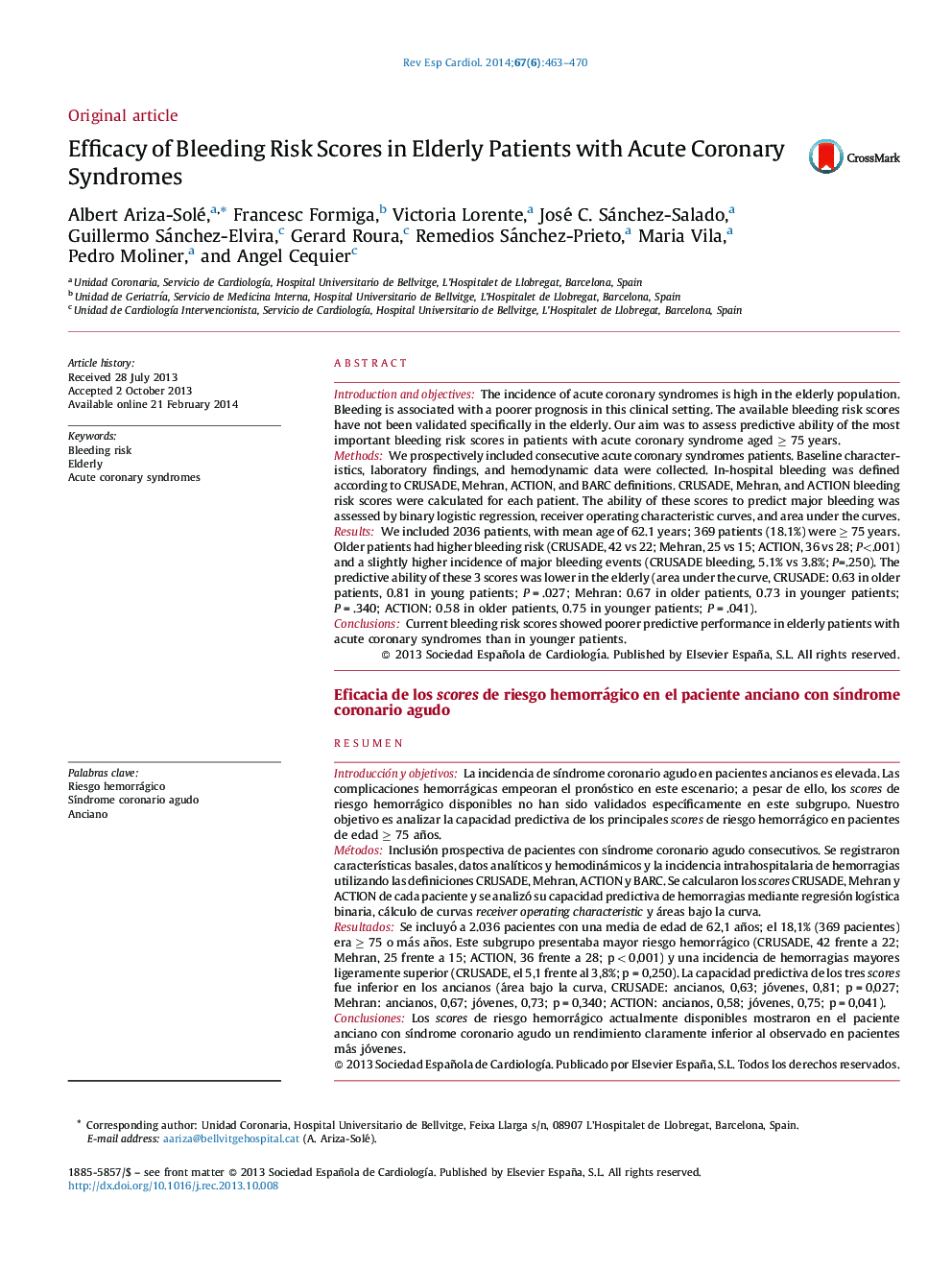| کد مقاله | کد نشریه | سال انتشار | مقاله انگلیسی | نسخه تمام متن |
|---|---|---|---|---|
| 3017432 | 1182119 | 2014 | 8 صفحه PDF | دانلود رایگان |
Introduction and objectivesThe incidence of acute coronary syndromes is high in the elderly population. Bleeding is associated with a poorer prognosis in this clinical setting. The available bleeding risk scores have not been validated specifically in the elderly. Our aim was to assess predictive ability of the most important bleeding risk scores in patients with acute coronary syndrome aged ≥ 75 years.MethodsWe prospectively included consecutive acute coronary syndromes patients. Baseline characteristics, laboratory findings, and hemodynamic data were collected. In-hospital bleeding was defined according to CRUSADE, Mehran, ACTION, and BARC definitions. CRUSADE, Mehran, and ACTION bleeding risk scores were calculated for each patient. The ability of these scores to predict major bleeding was assessed by binary logistic regression, receiver operating characteristic curves, and area under the curves.ResultsWe included 2036 patients, with mean age of 62.1 years; 369 patients (18.1%) were ≥ 75 years. Older patients had higher bleeding risk (CRUSADE, 42 vs 22; Mehran, 25 vs 15; ACTION, 36 vs 28; P<.001) and a slightly higher incidence of major bleeding events (CRUSADE bleeding, 5.1% vs 3.8%; P=.250). The predictive ability of these 3 scores was lower in the elderly (area under the curve, CRUSADE: 0.63 in older patients, 0.81 in young patients; P = .027; Mehran: 0.67 in older patients, 0.73 in younger patients; P = .340; ACTION: 0.58 in older patients, 0.75 in younger patients; P = .041).ConclusionsCurrent bleeding risk scores showed poorer predictive performance in elderly patients with acute coronary syndromes than in younger patients.
ResumenIntroducción y objetivosLa incidencia de síndrome coronario agudo en pacientes ancianos es elevada. Las complicaciones hemorrágicas empeoran el pronóstico en este escenario; a pesar de ello, los scores de riesgo hemorrágico disponibles no han sido validados específicamente en este subgrupo. Nuestro objetivo es analizar la capacidad predictiva de los principales scores de riesgo hemorrágico en pacientes de edad ≥ 75 años.MétodosInclusión prospectiva de pacientes con síndrome coronario agudo consecutivos. Se registraron características basales, datos analíticos y hemodinámicos y la incidencia intrahospitalaria de hemorragias utilizando las definiciones CRUSADE, Mehran, ACTION y BARC. Se calcularon los scores CRUSADE, Mehran y ACTION de cada paciente y se analizó su capacidad predictiva de hemorragias mediante regresión logística binaria, cálculo de curvas receiver operating characteristic y áreas bajo la curva.ResultadosSe incluyó a 2.036 pacientes con una media de edad de 62,1 años; el 18,1% (369 pacientes) era ≥ 75 o más años. Este subgrupo presentaba mayor riesgo hemorrágico (CRUSADE, 42 frente a 22; Mehran, 25 frente a 15; ACTION, 36 frente a 28; p < 0,001) y una incidencia de hemorragias mayores ligeramente superior (CRUSADE, el 5,1 frente al 3,8%; p = 0,250). La capacidad predictiva de los tres scores fue inferior en los ancianos (área bajo la curva, CRUSADE: ancianos, 0,63; jóvenes, 0,81; p = 0,027; Mehran: ancianos, 0,67; jóvenes, 0,73; p = 0,340; ACTION: ancianos, 0,58; jóvenes, 0,75; p = 0,041).ConclusionesLos scores de riesgo hemorrágico actualmente disponibles mostraron en el paciente anciano con síndrome coronario agudo un rendimiento claramente inferior al observado en pacientes más jóvenes.
Journal: Revista Española de Cardiología (English Edition) - Volume 67, Issue 6, June 2014, Pages 463–470
